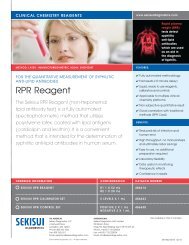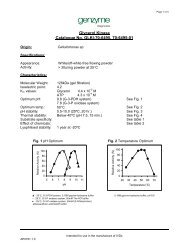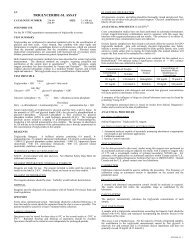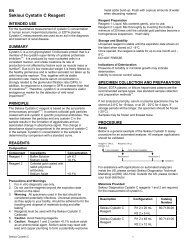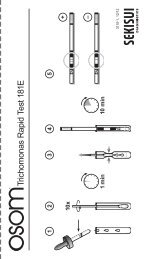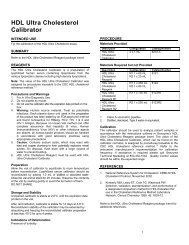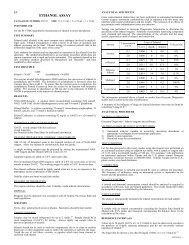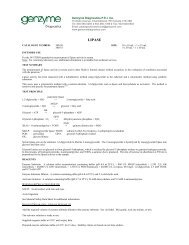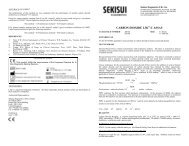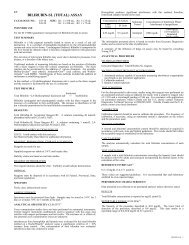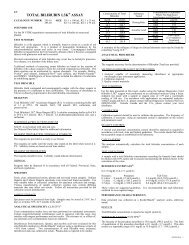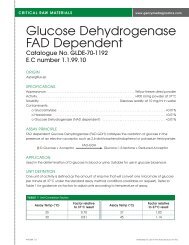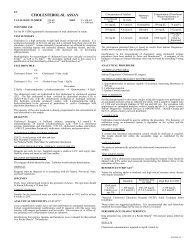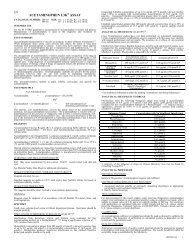SALICYLATE-SL ASSAY - Sekisui Diagnostics
SALICYLATE-SL ASSAY - Sekisui Diagnostics
SALICYLATE-SL ASSAY - Sekisui Diagnostics
You also want an ePaper? Increase the reach of your titles
YUMPU automatically turns print PDFs into web optimized ePapers that Google loves.
EN<strong>SALICYLATE</strong>-<strong>SL</strong> <strong>ASSAY</strong>CATALOGUE NUMBER: 511-40 SIZE: 4 x 10 mL, 4 x 10 mLINTENDED USEFor the IN VITRO quantitative measurement of salicylate concentration in serumand plasma.TEST SUMMARYSalicylate is a common drug used for its analgesic and anti-inflammatoryproperties. Its accessibility leads to its implication in a large number of accidentalingestions by children and it is a common choice among adults and adolescents forattempted suicidal poisoning. (1)Salicylate overdose results in disturbances of the central nervous system and thegastrointestinal tract as well as encephalopathy and renal failure. It represents anacute medical emergency and rapid quantitation of the drug is necessary foreffective patient management.(2)Salicylate has been traditionally measured by the "Trinder Reaction" which isbased on the interaction between salicylate and ferric ions. This test however isnot specific and requires extraction or centrifugation which inhibit the automationof the test.This enzymatic Salicylate Assay provides a rapid, specific and simplified methodfor salicylate measurement. It is based on the action of salicylate hydroxylase onsalicylate and NADH which results in a decrease in absorbance proportional to theamount of salicylate present. (3) The test can be adapted to automated instrumentsresulting in rapid, accurate results required by physicians.TEST PRINCIPLESalicylate hydroxylaseSalicylate + NADH + H + → Catechol + NAD +Salicylate hydroxylase catalyzes the conversion of salicylate and NADH tocatechol and NAD in the presence of oxygen. The resulting decrease inabsorbance at 340 nm, due to the conversion of NADH to NAD, is directlyproportional to the concentration of salicylate in the sample.REAGENTSSalicylate-<strong>SL</strong> Enzyme Reagent: A solution containing a buffer (pH 7.6 at 25°C),at least 770 U/L salicylate hydroxylase (microbial), stabilizers and a preservative.Salicylate-<strong>SL</strong> NADH Reagent: A solution containing a buffer (pH 10.4 at 25°C)and 1.2 mmol/L NADH.Salicylate Calibrator: 1 x 5 mL of a solution containing 20.7 mg/dL (1.50mmol/L) salicylate, and a preservative.WARNINGS & PRECAUTIONS FOR USES20: When using, do not eat or drink.S24/25: Avoid contact with skin and eyes.See Material Safety Data Sheet for additional information.REAGENT PREPARATION, STORAGE AND STABILITYReagents are ready for use. Supplied reagents are stable at 2-8°C until expirydate. Stability claims are based on real time studies.REAGENT DETERIORATIONThe reagent solutions should be clear. Turbidity would indicate deterioration.DISPOSALReagents must be disposed of in accordance with all Federal, Provincial, State,and local regulations.SPECIMENFresh, clear, unhemolysed serum or lithium heparinized plasma.SAMPLE STORAGESpecimens for analysis should be assayed promptly.ANALYTICAL SPECIFICITY (CLSI EP7) (4)Cross contamination studies have not been performed on automated instruments.Certain reagent/ instrument combinations used in sequence with this assay mayinterfere with reagent performance and test results. The existence of, or effects of,any potential cross contamination issues are unknown.Interferences from icterus, lipemia, and hemolysis were evaluated for thissalicylate method on a Roche/Hitachi ® 717 analyzer using a significance criterionof >10% variance from control. Interference data was collected in serum. Plasmadata is expected to be similar.Concentration of AnalyteConventionalUnitsSI UnitsSubstanceTestedConcentration of InterferentWhere Interference isInsignificant35.6 mg/dL 2.58 mmol/L Hemoglobin 400 mg/dL 62 μmol/L36.9 mg/dL 2.67 mmol/L Bilirubin 40 mg/dL 684 μmol/L36.5 mg/dL 2.64 mmol/L Intralipid 800 mg/dL2400 mg/dL(27.1 mmol/L)SimulatedTriglyceridesThe information presented above is based on results from <strong>Sekisui</strong> <strong>Diagnostics</strong>studies and is current at the date of publication.A summary of the influence of drugs on clinical laboratory tests may be found byconsulting Young, D.S. (5)ANALYTICAL PROCEDUREMATERIALS PROVIDED<strong>Sekisui</strong> <strong>Diagnostics</strong>’ Salicylate reagents and Salicylate calibrator.MATERIALS REQUIRED (BUT NOT PROVIDED)1. Automated analyzer capable of accurately measuring absorbance at appropriatewavelength as per instrument application.2. Quality Control materials.TEST CONDITIONFor the data presented in this insert, studies using this reagent were performed onan automated analyzer using an endpoint test mode, with a sample to reagent ratioof 1:16:33(Dil):35 and wavelength readings of (primary/secondary) 340/376 nm.For assistance with applications on automated analyzers within Canada and theU.S., please contact <strong>Sekisui</strong> <strong>Diagnostics</strong> Technical Services at (800)565-0265.Outside Canada and the U.S., please contact your local distributor.CALIBRATIONA salicylate calibrator is included with the reagents and should be used as directedto calibrate the procedure. The frequency of calibration on automated systems isdependent on the system and the parameters used.QUALITY CONTROLAppropriate concentrations of quality control material should be analyzed asrequired in accordance with local, state and federal guidelines. The results shouldfall within the acceptable range as established by the laboratory.CALCULATIONSThe analyzer automatically calculates the salicylate concentration of each sample.TEST LIMITATIONSA sample with a salicylate concentration exceeding the linearity limit should bediluted with 0.9% saline and reassayed incorporating the dilution factor in thecalculation of the value.REFERENCE INTERVALS (6)Toxic concentration: greater than 30.0 mg/dL (2.17 mmol/L)These values are suggested guidelines. It is recommended that each laboratoryestablish its own expected range.PERFORMANCE CHARACTERISTICSData presented was collected on a Roche/Hitachi ® 717 analyzer unless otherwisestated.(IN51120-11) Page 1 of 10
RESULTSSalicylate concentration is reported as mg/dL (mmol/L).REPORTABLE RANGE (CLSI EP6) (4)The linearity of the procedure described is 100.0 mg/dL (7.24 mmol/L). The limitof quantitation of the procedure described is 5.3 mg/dL (0.38 mmol/L). This dataresults in a reportable range of 5.3-100.0 mg/dL (0.38-7.24 mmol/L).PRECISION STUDIES (CLSI EP5) (4)Total precision data was collected on four concentrations of control sera using asingle lot of reagent in 40 runs conducted over 20 days. Within run precision datawas collected by assaying twenty samples of four concentrations of control sera inone run using one lot of reagent.Concentration Total SD Total Concentration Within Run SD WithinCV%Runmg/dL mmol/L mg/dL mmol/L mg/dL mmol/L mg/dL mmol/L CV%9.2 0.67 0.66 0.048 7.2 8.9 0.64 0.43 0.031 4.816.6 1.20 0.90 0.065 5.4 16.3 1.18 0.60 0.043 3.734.9 2.53 1.18 0.085 3.4 33.5 2.43 0.52 0.038 1.549.5 3.58 1.78 0.129 3.6 47.2 3.42 0.65 0.047 1.4ACCURACY (CLSI EP9) (4)The performance of this method (y) was compared with the performance of asimilar salicylate method (x) on a Roche/Hitachi ® 717. Thirty-nine patient serumsamples ranging from 9.3-93.0 mg/dL (0.67-6.74 mmol/L) gave a correlationcoefficient of 0.9986. Linear regression analysis gave the following equation:This method = 1.02 (reference method) – 0.4 mg/dL (0.03 mmol/L)The performance of this method (y) with plasma was compared with theperformance of this method (x) with serum on a Roche Hitachi ® 717. Twenty-sixpatient serum and plasma samples spiked with salicylate ranging from 7.7-93.6mg/dL (0.56-6.78 mmol/L) gave a correlation coefficient of 0.9972. Linearregression analysis gave the following equation:This method = 1.01 [<strong>Sekisui</strong> serum method] - 0.7 mg/dL (0.05 mmol/L)The information presented above is based on results from <strong>Sekisui</strong> <strong>Diagnostics</strong>studies and is current at the date of publication.All trademarks, brands, product names and trade names are the property of theirrespective companies.Manufactured by:The AmericasInternational<strong>Sekisui</strong> <strong>Diagnostics</strong> P.E.I. Inc.<strong>Sekisui</strong> <strong>Diagnostics</strong> (UK) Limited70 Watts Avenue 50 Gibson DriveCharlottetown, PE C1E 2B9Kings Hill, West MallingCanadaKENT, ME19 4AF, UKPhone: 800-565-0265Email: info@sekisuidiagnostics.comFax: 902-628-6504Email: questions@sekisuidiagnostics.compeidiagnostictechnical@sekisuidiagnostics.comwww.sekisuidiagnostics.comFRDOSAGE BIOLOGIQUE DU <strong>SALICYLATE</strong>-<strong>SL</strong>NUMÉRO DE CATALOGUE: 511-40UTILISATION PRÉVUETAILLE: 4 x 10 mL, 4 x 10 mLPour la mesure quantitative IN VITRO de la concentration du salicylate dans lesérum et le plasma.RÉSUMÉ DES TEST<strong>SL</strong>e salicylate est un médicament couramment utilisé pour ses propriétésanalgésiques et anti-inflammatoires. Le fait qu'il soit facilement disponible l'aimpliqué dans de nombreuses ingestions accidentelles par des enfants, et en fait unchoix courant chez les adultes et les adolescents dans le cadre des tentatives desuicide par empoisonnement. (1)Une surdose de salicylate entraîne des perturbations du système nerveux central etdu tractus gastro-intestinal, ainsi qu'une encéphalopathie et une insuffisancerénale. Il s'agit d'une urgence médicale grave, et il est nécessaire d'effectuer unerapide quantification du médicament pour pouvoir traiter le patient de façonefficace. (2)Le salicylate est généralement mesuré par la « réaction Trinder », basée surl'interaction du salicylate et des ions ferriques. Cependant, ce test n'est passpécifique et nécessite une extraction ou une centrifugation, ce qui empêche sonautomatisation.Ce dosage enzymatique du salicylate offre une méthode rapide, spécifique etsimplifiée pour mesurer le salicylate. Il repose sur l'action de la salicylatehydroxylase sur le salicylate et le NADH et entraîne une chute d'absorbanceproportionnelle à la quantité de salicylate présente. (3) Le test peut être adapté à desinstruments automatiques, ce qui produit les résultats rapides et précis dont lesmédecins ont besoin.PRINCIPE DU TESTSalicylate hydroxylaseSalicylate + NADH + H + → Catéchol + NAD +La salicylate hydroxylase catalyse la transformation du salicylate et du NADH encatéchol et en NAD en présence d'oxygène. La chute d'absorbance à 340 nm,attribuable à la transformation du NADH en NAD, est directement proportionnelleà la concentration du salicylate présent dans l'échantillon.RÉACTIFSRéactif enzymatique du salicylate-<strong>SL</strong>: Une solution contenant un tampon (pH de7,6 à 25 °C), au minimum 770 U/L de salicylate hydroxylase (microbienne), desagents stabilisants et un agent de conservation.Réactif NADH du salicylate-<strong>SL</strong>: Une solution contenant un tampon (pH de 10,4 à25 °C) et du NADH à 1,2 mmol/L.Agent d'étalonnage du salicylate: 1 x 5 mL d’une solution contenant20,7 mg/dL (1,50 mmol/L) de salicylate et un agent de conservation.PRÉCAUTIONS ET MISES EN GARDE RELATIVES À L'EMPLOIS20 : ne mangez et ne buvez pas pendant l'utilisation.S24/25 : Évitez le contact avec la peau et les yeux.Voir la fiche de données de sécurité (Material Safety Data Sheet) pourrenseignements supplémentaires.PRÉPARATION, CONSERVATION ET STABILITÉ DU RÉACTIFLes réactifs sont prêts à être utilisés. Les réactifs fournis sont stables entre 2 et8 °C jusqu'à la date de péremption. Les déclarations de stabilité sont fondées surdes études en temps réel.DÉTÉRIORATION DU RÉACTIFLes solutions de réactif doivent être transparentes. La turbidité est donc un signede détérioration.ÉLIMINATIONLes réactifs doivent être éliminés conformément à toutes les réglementationslocales, fédérales, provinciales et étatiques.(IN51120-11) Page 2 of 10
SPÉCIMENSérum frais, transparent, sans hémolyse, ou plasma à héparine de lithium.CONSERVATION DE L'ÉCHANTILLONLes spécimens à analyser doivent être rapidement dosés.SPÉCIFICITÉ ANALYTIQUE (CLSI EP7) (4)Aucune étude de contamination croisée n'a été effectuée sur les instrumentsautomatisés. Certaines combinaisons de réactifs ou d'instruments utilisés enséquence dans le cadre du présent dosage biologique peuvent influer sur lecomportement du réactif et les résultats des tests. L'existence d'une contaminationcroisée ou ses effets potentiels ne sont pas connus.Les interférences avec l'ictère, l'hyperlipidémie et l'hémolyse ont été évaluéesrelativement à cette méthode au salicylate sur l'analyseur Roche/Hitachi ® 717selon un critère d'importance d'une variance supérieure à 10 % par rapport aucontrôle. Les données relatives à l'interférence ont été recueillies dans le sérum.Les données obtenues dans le plasma seront probablement similaires.Concentration de la substanceà analyserUnitésUnités SIconventionnellesSubstancetestéeConcentration de lasubstance interférentelorsque l'interférence estnégligeable35,6 mg/dL 2,58 mmol/L Hémoglobine 400 mg/dL 62 μmol/L36,9 mg/dL 2,67 mmol/L Bilirubine 40 mg/dL 684 μmol/L36,5 mg/dL 2,64 mmol/L Intralipid 800 mg/dL2 400 mg/dL(27,1 mmol/L)triglycéridessimulésLes renseignements susmentionnés sont basés sur les résultats obtenus dans lecadre des études de <strong>Sekisui</strong> <strong>Diagnostics</strong>. Ils sont à jour à la date de publication.Un résumé de l'influence des médicaments sur les tests de laboratoire clinique estdisponible chez Young, D.S. (5)PROCÉDURE ANALYTIQUEMATÉRIEL FOURNIAgent d'étalonnage et réactifs du salicylate de <strong>Sekisui</strong> <strong>Diagnostics</strong>.MATÉRIEL REQUIS (MAIS NON FOURNI)1. Analyseur automatisé capable de mesurer précisément l'absorbance à deslongueurs d'onde appropriées, selon l'application de l'instrument.2. Matériaux de contrôle de la qualité.CONDITIONS DU TESTConcernant les données présentées dans cet encart, les études ayant fait appel à ceréactif ont été effectuées sur un analyseur automatisé à l'aide d'un mode d'essaiultime, avec un échantillon dont le rapport avec le réactif est de 1:16:33(dilué):35et une lecture de la longueur d'onde (primaire/secondaire) de 340 nm ou de 376nm. Pour obtenir de l'aide au sujet de l'utilisation des analyseurs automatisés auCanada et aux États-Unis, veuillez communiquer avec les services techniques de<strong>Sekisui</strong> <strong>Diagnostics</strong> au 1-800-565-0265. À l'extérieur du Canada et des États-Unis,veuillez communiquer avec votre distributeur local.ÉTALONNAGEUn agent d'étalonnage du salicylate est compris avec les réactifs et doit être utiliséselon les directives afin d'étalonner la procédure. La fréquence de l'étalonnage surles systèmes automatisés dépend du système et des paramètres utilisés.INTERVALLES DE RÉFÉRENCE (6)Concentration toxique : supérieure à 30,0 mg/dL (2,17 mmol/L)Ces valeurs sont suggérées à titre indicatif. Il est recommandé que chaquelaboratoire détermine sa propre fourchette normale.CARACTÉRISTIQUES LIÉES AU COMPORTEMENTSauf indication contraire, les données présentées ont été recueillies sur unanalyseur Roche/Hitachi ® 717.RÉSULTAT<strong>SL</strong>a concentration en salicylate est exprimée en mg/dL (mmol/L).INTERVALLE DE SIGNALEMENT REPORTABLE (CLSI EP6) 4)La linéarité de la procédure décrite est de 100,0 mg/dL (7,24 mmol/L). La limitede l'analyse quantitative pour la procédure décrite est de 5,3 mg/dL (0,38mmol/L). Ces données se situent dans un intervalle de signalement variant entre5,3 et 100,0 mg/dL (0,38 et 7,24 mmol/L).ÉTUDES DE PRÉCISION (CLSI EP5) (4)Les données ont été recueillies à partir de quatre concentrations de sérums decontrôle en faisant appel à un lot simple de réactifs dans le cadre de 40 sériesmenées sur une période de 20 jours. Les données de précision intra-séries ont étérecueillies en effectuant un dosage biologique sur vingt échantillons de quatreconcentrations de sérums de contrôle dans le cadre d'une série au moyen d'un lotde réactif.Écart-type intrasérieintra-Concentration Écart-type total % CV Concentration% CVtotalmg/dL mmol/L mg/dL mmol/L mg/dL mmol/L mg/dL mmol/L série9,2 0,67 0,66 0,048 7,2 8,9 0,64 0,43 0,031 4,816,6 1,20 0,90 0,065 5,4 16,3 1,18 0,60 0,043 3,734,9 2,53 1,18 0,085 3,4 33,5 2,43 0,52 0,038 1,549,5 3,58 1,78 0,129 3,6 47,2 3,42 0,65 0,047 1,4EXACTITUDE (CLSI EP9) (4)Le comportement de cette méthode (y) a été comparé avec celui d'une autreméthode (x) similaire mesurant le taux de salicylate sur un appareilRoche/Hitachi ® 717. Les échantillons provenant de trente-neuf patients dont lateneur en salicylate dans le sérum variait entre 9,3 et 93,0 mg/dL (0,67 et 6,74mmol/L) ont donné un coefficient de corrélation égal à 0,9986. L'équationsuivante a été obtenue à l'issue de l'analyse de régression linéaire :Cette méthode = 1,02 (méthode de référence) – 0,4 mg/dL (0,03 mmol/L)Le comportement de cette méthode (y) faisant appel à des échantillons de plasmaa été comparé avec celui de la méthode (x) faisant appel à des échantillons desérum sur un analyseur Roche Hitachi ® 717. Les échantillons provenant de vingtsixpatients dont la teneur en salicylate dans le plasma variait entre 7,7 et 93,6mg/dL (0,56 et 6,78 mmol/L) ont donné un coefficient de corrélation égal à0,9972. L'équation suivante a été obtenue à l'issue de l'analyse de régressionlinéaire :Cette méthode = 1,01 [méthode relative au sérum de <strong>Sekisui</strong>] - 0,7 mg/dL (0,05mmol/L)Les renseignements susmentionnés sont basés sur les résultats obtenus dans lecadre des études de <strong>Sekisui</strong> <strong>Diagnostics</strong>. Ils sont à jour à la date de publication.Tous les noms commerciaux, les noms de marque de commerce, de marque et deproduit sont la propriété de leurs sociétés respectives.Fabriqué par:CONTRÔLE DE LA QUALITÉDes concentrations appropriées de matériel de contrôle de la qualité doivent êtreanalysées conformément aux directives locales, d'État et fédérales. Les résultatsdoivent se situer dans la fourchette acceptable déterminée par le laboratoire.CALCUL<strong>SL</strong>'analyseur calcule automatiquement la concentration de salicylate dans chaqueéchantillon.LIMITES DES TESTSUn échantillon dont la concentration en salicylate dépasse la limite de linéaritédoit être dilué dans une solution saline à 0,9 % et faire l'objet d'un autre dosage quiintègre le facteur de dilution dans le calcul de la valeur.Les AmériquesInternational<strong>Sekisui</strong> <strong>Diagnostics</strong> P.E.I. Inc. <strong>Sekisui</strong> <strong>Diagnostics</strong> (UK) Limited70, avenue Watts 50 Gibson DriveCharlottetown (Île-du-Prince-Édouard) Kings Hill, West MallingC1E 2B9 CanadaKENT, ME19 4AF, RUTéléphone: 1-800-565-0265Courriel: info@sekisuidiagnostics.comTélécopieur: 902-628-6504Courriel: questions@sekisuidiagnostics.compeidiagnostictechnical@sekisuidiagnostics.comwww.sekisuidiagnostics.com(IN51120-11) Page 3 of 10
ESANÁLISIS DE SALICILATO-<strong>SL</strong>NÚMERO DE CATÁLOGO: 511-40USO PARA EL QUE FUE DISEÑADOTAMAÑO: 4 x 10 ml, 4 x 10 mlPara la medición cuantitativa IN VITRO de la concentración de salicilato en sueroy en plasma.RESUMEN DEL ANÁLISISEl salicilato es un medicamento común empleado debido a sus propiedadesanalgésicas y antiinflamatorias. Su disponibilidad ha incidido en el gran númerode casos de ingestión accidental por niños, y es una substancia que tanto adultoscomo jóvenes tienden a elegir para tratar de suicidarse. (1)La sobredosis de salicilato produce trastornos al sistema nervioso central y a lasvías gastrointestinales, así como encefalopatía e insuficiencia renal. La mismaconstituye una emergencia médica grave, que hace necesaria la medición rápidadel nivel de droga para tratar eficazmente al paciente. (2)Tradicionalmente, la cantidad de salicilato se ha medido empleando la "reacciónde Trinder", que se basa en la interacción entre el salicilato y los iones de hierro.Sin embargo, este análisis no es específico y requiere la extracción o elprocesamiento centrífugo de las muestras, lo que impide la automatización delanálisis.Este análisis enzimático del salicilato proporciona un método rápido, específico ysimple para medir el salicilato. Se basa en la acción de la hidroxilasa de salicilatosobre el salicilato y el dinucleótido de adenina nicotinamida (NADH, por sussiglas en inglés), que produce una disminución de absorbencia proporcional a lacantidad de salicilato presente. (3) El análisis se puede adaptar a instrumentosautomatizados, proporcionándole resultados rápidos y precisos a los médicos.PRINCIPIO DEL ANÁLISISHidroxilasa de salicilatoSalicilato + NADH + H + → Catecol + NAD +La hidroxilasa de salicilato actúa como catalizador para convertir el salicilato y elNADH en catecol y NAD en presencia de oxígeno. La resultante disminución deabsorbencia a 340 nm debido a la conversión de NADH a NAD, es directamenteproporcional a la concentración de salicilato en la muestra.AGENTES REACTIVOSAgente reactivo de enzima para salicilato-<strong>SL</strong>: solución que contiene un tampón(pH 7.6 a 25° C), un mínimo de 770 u/l de hidroxilasa de salicilato (microbiana),estabilizadores y un agente conservante.Agente reactivo de NADH para salicilato-<strong>SL</strong>: solución que contiene un tampón(pH 10.4 a 25° C) y 1.2 mmol/l de NADH.Calibrador de salicilato: 1 x 5 ml de una solución que contiene 20.7 mg/dl (1.50mmol/l) de salicilato, y un agente conservante.ADVERTENCIAS Y MEDIDAS DE PRECAUCIÓN PARA SU USOS20: No ingiera alimentos ni bebidas cuando use este producto.S24/25: Evite el contacto con la piel y los ojos.Para obtener mayor información, lea la hoja de datos de seguridad de materiales.PREPARACIÓN, ALMACENAMIENTO Y ESTABILIDAD DEL AGENTEREACTIVOLos agentes reactivos vienen listos para su uso. Los agentes reactivos que sesuministran son estables hasta la fecha de caducidad, a una temperatura de 2 a 8°C. Las afirmaciones acerca de la estabilidad se fundan en estudios realizados entiempo real.DETERIORO DEL AGENTE REACTIVOEl agente reactivo debe ser transparente. La turbidez podría ser una indicación dedeterioro.ELIMINACIÓNLos agentes reactivos se deben eliminar de acuerdo con las estipulaciones de lasnormas federales, provinciales, estatales y locales.MUESTRAMuestra de suero recién sacado, transparente, sin hemolizar, o de plasmaheparinizado con litio.ALMACENAMIENTO DE LAS MUESTRA<strong>SL</strong>as muestras de análisis se deben analizar de inmediato.ESPECIFICIDAD ANALÍTICA (CLSI EP7) (4)No se ha realizado estudios de contaminación cruzada en instrumentosautomatizados. Ciertas combinaciones de agentes reactivos / instrumentosempleados en secuencia en este análisis pueden interferir con las característicasdel agente reactivo y los resultados del análisis. Se desconoce si existenproblemas de posible contaminación cruzada, o de sus efectos.Para este método de análisis del salicilato se evaluó la interferencia producida porla ictericia, la presencia de lípidos en la sangre y la hemólisis, en un analizador717 de Roche/Hitachi ® , aplicando un criterio de relevancia de más de un 10% dedesviación de la media de control. Los datos de interferencia se recogieron ensuero. Se estima que los datos para el plasma sean similares.Concentración del analizadoUnidadesconvencionalesUnidades delSISubstanciaanalizadaConcentración deinterferente en casos en quela interferencia esinsignificante35.6 mg/dl 2.58 mmol/l Hemoglobina 400 mg/dl 62 μmol/l36.9 mg/dl 2.67 mmol/l Bilirrubina 40 mg/dl 684 μmol/l36.5 mg/dl 2.64 mmol/l Intralípido 800 mg/dl2400 mg/dl(27.1 mmol/l)de triglicéridossimuladosLa información que se presenta arriba se funda en los resultados de los estudiospracticados por <strong>Sekisui</strong> <strong>Diagnostics</strong>, y está vigente a la fecha de su publicación.Se puede obtener un resumen de la influencia de los medicamentos en estudiosclínicos de laboratorio consultando a Young, D.S. (5)PROCEDIMIENTO ANALÍTICOMATERIALES SUMINISTRADOSAgentes reactivos y calibrador de salicilato de <strong>Sekisui</strong> <strong>Diagnostics</strong>.MATERIALES NECESARIOS (PERO NO SUMINISTRADOS)1. Analizador automatizado capaz de medir con precisión la absorbencia a unalongitud de onda adecuada según la aplicación por instrumento.2. Materiales de control de calidad.CONDICIÓN DEL ANÁLISISPara la obtención de los datos que se presentan en este encarte, se realizaronestudios con este agente reactivo en un analizador automatizado en modo deanálisis de punto final, con una proporción de 1:16:33(Dil):35 entre la muestra y elagente reactivo, y una lectura de longitud de onda de 340/376 nm(primaria/secundaria). Si desea ayuda para aplicaciones en analizadoresautomatizados en Canadá o EE UU, comuníquese con <strong>Sekisui</strong> <strong>Diagnostics</strong>Technical Services llamando al teléfono (800) 565-0265. En otros países, llame aldistribuidor de su localidad.CALIBRACIÓNCon los agentes reactivos viene un calibrador de salicilato, que se debe emplearpara calibrar el procedimiento según las indicaciones. La frecuencia de lacalibración de los sistemas automatizados depende del sistema y de los parámetrosaplicados.CONTROL DE CALIDADLas concentraciones correctas de material de control de calidad se deben analizaren la medida en que se requiera, según los lineamientos locales, estatales yfederales. Los resultados deben estar dentro de los límites aceptables establecidospor el laboratorio.CÁLCULOSEl analizador calcula automáticamente la concentración de salicilato de cadamuestra.LIMITACIONES DEL ANÁLISISDeben diluirse con una solución salina al 0.9% y volver a analizarse las muestras(IN51120-11) Page 4 of 10
con una concentración de salicilato que supere la linealidad, teniendo en cuenta elfactor de dilución en el cálculo del valor.INTERVALOS DE REFERENCIA (6)Concentración tóxica: superior a 30.0 mg/dl (2.17 mmol/l)Estos valores se sugieren como pauta. Se recomienda que cada laboratorioestablezca sus propios límites estimados.CARACTERÍSTICAS DE LOS RESULTADO<strong>SL</strong>os datos que aquí se presentan fueron recogidos empleando un analizador 717 deRoche/Hitachi ® , salvo que se indique lo contrario.RESULTADO<strong>SL</strong>a concentración de salicilato se indica en mg/dl (mmol/l).LÍMITES SIGNIFICATIVOS (CLSI EP6) (4)La linealidad del procedimiento descrito es de 100.0 mg/dl (7.24 mmol/l). Ellímite de detección cuantitativa del procedimiento descrito es 5.3 mg/dl (0.38mmol/l). Estos datos caen dentro de los límites significativos de entre 5.3 y 100.0mg/dl (0.38 y 7.24 mmol/l).ESTUDIOS DE PRECISIÓN (CLSI EP5) (4)Los datos de precisión total fueron recogidos en cuatro muestras de suero decontrol empleando un solo lote de agente reactivo en cuarenta pruebas realizadasdurante un período de 20 días. Los datos de precisión de cada prueba seobtuvieron analizando veinte muestras de cuatro concentraciones de suero decontrol en una prueba empleando un lote de agente reactivo.Concentración SD totalCVtotalConcentraciónSD dentro dela pruebamg/dl mmol/l mg/dl mmol/l en % mg/dl mmol/l mg/dl mmol/lCV en%dentrode laprueba9.2 0.67 0.66 0.048 7.2 8.9 0.64 0.43 0.031 4.816.6 1.20 0.90 0.065 5.4 16.3 1.18 0.60 0.043 3.734.9 2.53 1.18 0.085 3.4 33.5 2.43 0.52 0.038 1.549.5 3.58 1.78 0.129 3.6 47.2 3.42 0.65 0.047 1.4PRECISIÓN (CLSI EP9) (4)Los resultados de este método (y) se compararon con los de un método similar deanálisis de salicilato (x), empleando un analizador 717 de Roche/Hitachi ® . Elanálisis de las muestras de suero de treinta y nueve pacientes, con límites de entre9.3 y 93.0 mg/dl (entre 0.67 y 6.74 mmol/l) dio un coeficiente de correlación de0.9986. El análisis de regresión lineal dio la siguiente ecuación:Este método = 1.02 (método de referencia) - 0.4 mg/dl (0.03 mmol/l)Los resultados de este método de análisis con plasma (y) se compararon con los deeste método con suero (x), empleando un analizador 717 de Roche Hitachi ® . Elanálisis de las muestras de suero y de plasma de veintiséis pacientes, con límitesde entre 7.7 y 93.6 mg/dl (entre 0.56 y 6.78 mmol/l) dio un coeficiente decorrelación de 0.9972. El análisis de regresión lineal dio la siguiente ecuación:Este método = 1.01 [Método con suero de <strong>Sekisui</strong>] - 0.7 mg/dl (0.05 mmol/l)La información que se presenta arriba se funda en los resultados de los estudiospracticados por <strong>Sekisui</strong> <strong>Diagnostics</strong>, y está vigente a la fecha de su publicación.Todas las marcas de fábrica, marcas, nombres de productos y nombrescomerciales son de propiedad de sus respectivas empresas.Elaborado por:ITSAGGIO SALICILATO-<strong>SL</strong>NUMERO CATALOGO: 511-40 CONFEZIONE DA: 4 x 10 mL, 4 x 10 mLDESTINAZIONE D'USOPer la misurazione IN VITRO della quantità di salicilato nel siero e nel plasma.RIEPILOGO DEL TESTIl salicilato è un farmaco comunemente usato per le sue proprietà analgesiche eantinfiammatorie. La sua accessibilità fa sì che sia spesso ingerito accidentalmenteda parte di bambini e che sia scelto da molti adulti e adolescenti che intendonotentare di avvelenarsi. (1)Un'overdose di salicilato causa disturbi del sistema nervoso centrale edell'apparato gastrointestinale come pure encefalopatia e blocco renale. Si trattadi un'emergenza medica acuta e una rapida quantificazione del farmaco ènecessaria per un trattamento efficace del paziente. (2)Il salicilato è tradizionalmente misurato con la "Reazione di Trinder" che si basasull'interazione tra il salicilato e gli ioni ferrici. Questo test non è però specifico erichiede estrazione o centrifugazione: per questo l'automatizzazioen dell'analisi èpreclusa.Questo saggio enzimatico per il salicilato fornisce un metodo rapido, specifico esemplificato per la misurazione del salicilato. Si basa sull'azione del salicilatoidrossilasi sul salicilato e sulla NADP, che risulta in una riduzione dell'assorbanzaproporzionale alla quantità di salicilato presente. (3) Il test può venire adattato allastrumentazione automatica, producendo i risultati rapidi e accurati richiesti daisanitari.PRINCIPIO DEL TESTSalicilato idrossilasiSalicilato + NADP + H + → Catecolo + NAD +La salicilato idrossilasi catalizza la conversione del salicilato e della NADP acatecolo e NAD in presenza di ossigeno. La risultante riduzione nell'assorbanza a340 nm, dovuta alla conversione della NADP in NAD, è direttamenteproporzionale alla concentrazione di salicilato nel campione.REAGENTIReagente enzimatico Salicilato-<strong>SL</strong>: soluzione contenente un tampone (pH 7,6 a25°C), almeno 770 U/L di salicilato idrossilasi (microbica), stabilizzanti e unconservante.Reagente NADP Salicilato-<strong>SL</strong>: soluzione contenente un tampone (pH 10,4 a25°C) e 1,2 mmol/L di NADP.Taratura del salicilato: 1 x 5 mL di soluzione contenente 20,7 mg/dL (1.50mmol/L) di salicilato e un conservante.AVVERTENZE E PRECAUZIONI PER L'USOS20: Non mangiare né bere durante l'impiego.S24/25: Evitare il contatto con gli occhi e con la pelle.Consultare la Scheda Tecnica di Sicurezza dei Materiali per ulteriori informazioni.PREPARAZIONE, CONSERVAZIONE E STABILITÀ DEL REAGENTEI reagenti sono pronti per l'uso. I reagenti forniti sono stabili a 2-8°C fino alla datadi scadenza. La stabilità dichiarata si basa su studi in tempo reale.DETERIORAMENTO DEL REAGENTELe soluzioni reagenti devono apparire limpide. La torbidità indica deterioramento.SMALTIMENTOContinente americanoInternacional<strong>Sekisui</strong> <strong>Diagnostics</strong> P.E.I. Inc.<strong>Sekisui</strong> <strong>Diagnostics</strong> (UK) Limited70 Watts Avenue 50 Gibson DriveCharlottetown, PE C1E 2B9Kings Hill, West MallingCanadaKENT, ME19 4AF, RUTeléfono: 800-565-0265Correo electrónico:Fax: 902-628-6504info@sekisuidiagnostics.comCorreo electrónico:questions@sekisuidiagnostics.compeidiagnostictechnical@sekisuidiagnostics.comI reagenti vanno smaltiti in ottemperanza alle disposizioni federali, provinciali,statali e locali.CAMPIONE DI PROVASiero puro, limpido, non emolizzato o plasma eparinizzato al litio.CONSERVAZIONE DEI CAMPIONII campioni di prova da analizzare vanno saggiati immediatamente.www.sekisuidiagnostics.com(IN51120-11) Page 5 of 10
SPECIFICITÀ ANALITICA (CLSI EP7) (4)Non sono stati eseguiti studi sulla contaminazione reciproca su strumentiautomatici. Certe combinazioni reagente/strumento usate in sequenza con questosaggio possono interferire con le prestazioni del reagente e con gli esitidell'analisi. Non sono noti l'esistenza e gli effetti di eventuali problematiche dicontaminazione reciproca.Le interferenze da ittero, lipemia ed emolisi sono state valutate per questo metodoper salicilato su un analizzatore Roche/Hitachi ® 717 usando come criterio disignificatività una varianza di >10% rispetto al controllo. I dati sulle intereferenzesono stati raccolti nel siero. Ci si attende che i dati sul plasma daranno risultatisimili.Concentrazione di analitaUnitàconvenzionaliUnità SISostanzatestataConcentrazione di sostanzainterferente con interferenzanon significativa35,6 mg/dL 2,58 mmol/L Emoglobina 400 mg/dL 62 μmol/L36,9 mg/dL 2,67 mmol/L Bilirubina 40 mg/dL 684 μmol/L36,5 mg/dL 2,64 mmol/L Intralipid 800 mg/dL2400 mg/dL(27,1 mmol/L)Simulazione ditrigliceridiLe informazioni che precedono si basano su studi della <strong>Sekisui</strong> <strong>Diagnostics</strong> e sonoaggiornate alla data di pubblicazione.Un riepilogo dell'influenza dei farmaci sui test clinici di laboratorio è disponibileconsultando Young, D.S. (5)PROCEDURA ANALITICAMATERIALI IN DOTAZIONEReagenti per salicilato e taratura per salicilato della <strong>Sekisui</strong> <strong>Diagnostics</strong>.MATERIALI NECESSARI (MA NON IN DOTAZIONE)1. Analizzatore automatizzato in grado di misurare con precisione l'assorbanza alunghezze d'onda appropriate a seconda dell'applicazione dello strumento.2. Materiali per il controllo di qualità.CONDIZIONI DEL TESTPer i dati presentati nel presente foglietto illustrativo, gli studi condotti usandoquesto reagente sono stati eseguiti su un analizzatore automatico usando unamodalità di test dell'equilibrio dinamico, con un rapporto tra campione e reagentedi 1:16:33(Dil):35 e misurazioni della lunghezza d'onda di 340/376 nm(primaria/secondaria). Per assistenza con le applicazioni su analizzatoriautomatici in Canada e negli Stati Uniti, contattare i servizi tecnici della <strong>Sekisui</strong><strong>Diagnostics</strong> al numero (800)565-0265. Fuori dal Canada e dagli Stati Uniti,contattare il rivenditore locale.TARATURACoi reagenti è inclusa una soluzione di taratura di salicilato da usare come indicatoper calibrare la procedura. La frequenza della taratura dei sistemi automaticidipende dal sistema e dai parametri utilizzati.CONTROLLO DI QUALITÀConcentrazioni adeguate di materiali per il controllo di qualità vanno analizzatecome richiesto dalle linee guida locali, statali e federali. I risultati devonorientrare nella gamma accettabile stabilita dal laboratorio.CALCOLIL'analizzatore calcola automaticamente la concentrazione di salicilato in ciascuncampione.LIMITI DEL TESTPRESTAZIONI CARATTERISTICHEI dati presentati sono stati ottenuti con un analizzatore Roche/Hitachi ® 717 salvoove diversamente indicato.RISULTATILa concentrazione di salicilato è espressa in mg/dL (mmol/L).REPORTABLE GAMMA (CLSI EP6) (4)La linearità della procedura descritta è di 100,0 mg/dL (7,24 mmol/L). Il limite diquantificazione della procedura è di 5,3 mg/dL (0,38 mmol/L). Questi datiproducono una gamma riportabile di 5,3-100,0 mg/dL (da 0,38 a 7,24 mmol/L).STUDI DI PRECISIONE (CLSI EP5) (4)I dati sulla precisione totale sono stati raccolti saggiando quattro concentrazioni disieri di controllo con un solo reagente per un periodo di 20 giorni con 40 prove algiorno. I dati sulla precisione entro prova sono stati raccolti su quattroconcentrazioni di sieri di controllo, ciascuna ripetuta una volta usando unreagente.Concentrazione SD totaleConcentrazione SD entro prova % CV% CVentromg/dL mmol/L mg/dL mmol/L totale mg/dL mmol/L mg/dL mmol/Lprova9,2 0,67 0,66 0,048 7,2 8,9 0,64 0,43 0,031 4,816,6 1,20 0,90 0,065 5,4 16,3 1,18 0,60 0,043 3,734,9 2,53 1,18 0,085 3,4 33,5 2,43 0,52 0,038 1,549,5 3,58 1,78 0,129 3,6 47,2 3,42 0,65 0,047 1,4ACCURATEZZA (CLSI EP9) (4)Le prestazioni di questo metodo (y) sono state confrontate con quelle di unmetodo simile per la determinazione del salicilato (x) su un Roche/Hitachi ® 717. Icampioni di siero da trentanove pazienti, contenenti da 9,3 a 93,0 mg/dL (da 0,67a 6,74 mmol/L) hanno dato un coefficiente di correlazione di 0,9986. L'analisi diregressione lineare ha dato la seguente equazione:Questo metodo = 1,02 (metodo di riferimento) - 0,4 mg/dL (0,03 mmol/L)Le prestazioni di questo metodo (y) con plasma sono state paragonate alleprestazioni di questo metodo (x) con siero su un dispositivo Roche Hitachi ® 717. Icampioni su siero e su plasma prelevati da ventisei pazienti e addizionati consalicilato, varianti da 7,7 a 93,6 mg/dL (0,56-6,78 mmol/L) hanno fornito uncoefficiente di correlazione pari a 0,9972. L'analisi di regressione lineare ha datola seguente equazione:Questo metodo = 1,01 [Metodo <strong>Sekisui</strong> su siero] – 0,7 mg/dL (0,05 mmol/L)Le informazioni che precedono si basano sui risultati ottenuti dalla <strong>Sekisui</strong><strong>Diagnostics</strong> e sono aggiornate alla data di pubblicazione.Tutti i marchi di fabbrica, le marche, i nomi dei prodotti e i nomi commercialisono di proprietà delle rispettive società.Prodotto da:AmericheResto del mondo<strong>Sekisui</strong> <strong>Diagnostics</strong> P.E.I. Inc.<strong>Sekisui</strong> <strong>Diagnostics</strong> (UK) Limited70 Watts Avenue 50 Gibson DriveCharlottetown, PE C1E 2B9Kings Hill, West MallingCanadaKENT, ME19 4AF, UKTelefono: 800-565-0265E-mail: info@sekisuidiagnostics.comFax: 902-628-6504E-mail: questions@sekisuidiagnostics.compeidiagnostictechnical@sekisuidiagnostics.comwww.sekisuidiagnostics.comUn campione con una concentrazione di salicilato eccedente il limite di linearitàva diluita con soluzione salina allo 0,9% e risaggiato incorporando nel calcolo delvalore il fattore di diluizione.INTERVALLI DI RIFERIMENTO (6)Concentrazione tossica: maggiore di 30,0 mg/dL (2,17 mmol/L)Questi valori sono linee guida suggerite. Si raccomanda che ogni laboratoriostabilisca la propria gamma di risultati previsti.(IN51120-11) Page 6 of 10
DESALICYLAT-<strong>SL</strong>-TESTKATALOGNUMMER: 511-40 GRÖSSE: 4 x 10 ml, 4 x 10 mlGEPLANTE VERWENDUNGFür die IN VITRO quantitative Messung von Salicylat-Konzentrationen in Serumund Plasma.ZUSAMMENFASSUNG DES VERSUCHSBei Salicylat handelt es sich um einen häufig verwendeten Wirkstoff, der aufgrundseiner schmerlindernden und entzündungshemmenden Eigenschaften eingesetztwird. Seine leichte Zugänglichkeit führt vielmals zu unbeabsichtigter Ingestiondurch Kinder und gehört zu den häufig eingenommenen Wirkstoffen unterErwachsenen sowie Jugendlichen in suizidaler Absicht. (1)Eine Salicylat-Überdosis führt zu Störungen des zentralen Nervensystems und desMagen-Darm-Trakts sowie zu Enzephalopathie und Nierenversagen. Dies stellteinen akuten medizinischen Notfall dar, bei dem eine schnelle Bestimmung desWirkstoffs zur effektiven Behandlungen des Patienten notwendig ist. (2)Traditionell werden Salicylate mithilfe der „Trinder-Reaktion“ gemessen, welcheauf der Interaktion zwischen dem Salicylat und Eisenionen basiert. Dieser Test istjedoch nicht genau und erfordert eine Extrahierung oder Zentrifugierung, die eineHinderung der Automatisierung des Tests darstellen.Dieser enzymatische Salicylat-Test bietet eine schnelle, präzise und einfacheMethode zur Messung von Salicylaten. Er basiert auf der Wirkung von Salicylat-Hydroxylase auf Salicylat und NADH, was zu einer Abnahme desAbsorptionsvermögens anteilmäßig zur vorliegenden Salicylat-Menge führt. (3)Dieser Test kann automatisierten Verfahren angepasst werden und somit die fürMediziner schnell benötigten sowie präzisen Resultate zur Verfügung stellen.VERSUCHSPRINZIPSalicylat-HydroxylaseSalicylat + NADH + H + → Catechol + NAD +Salicylat-Hydroxylase katalysiert die Umwandlung von Salicylat und NADH zuCatechol und NAD unter Sauerstoff. Die aufgrund der Umwandlung von NADHzu NAD resultierende Abnahme des Absorptionsvermögens bei 340 nm ist direktproportional zur Konzentration von Salicylat in der Probe.REAGENZIENSalicylat-<strong>SL</strong>-Enzymreagenz: Lösung mit Puffer (pH 7,6 bei 25°C), mindestens770 u/l Salicylat-Hydroxylase (bakteriell), Stabilisatoren und Konservierungsstoff.Salicylat-<strong>SL</strong>-NADH-Reagenz: Lösung mit Puffer (pH 10,4 bei 25°C) und 1,2mmol/l NADH.Salicylat-Kalibrator: 1 x 5 ml einer Lösung mit 20,7 mg/dl (1,50 mmol/l) Salicylatund Konservierungsstoff.WARNUNGEN & SICHERHEITSMASSNAHMEN FÜR DEN GEBRAUCHS20: Bei der Anwendung, nicht in den Mund nehmen.S24/25: Kontakt mit Haut und Augen vermeiden.Siehe Material-Sicherheitsdatenblatt für weitere Informationen.ZUBEREITUNG DER REAGENZ, LAGERUNG UND HALTBARKEITDie Reagenzien sind gebrauchsfertig. Die bereitgestellten Reagenzien sind biszum Verfallsdatum bei 2-8°C stabil. Stabilitätsansprüche stützen sich aufStabilitätsstudien in Echtzeit.REAGENZVERFALLDie Reagenzlösungen sollten klar sein. Trübheit deutet auf einen Verfall hin.ENTSORGUNGDie Reagenzien müssen entsprechend den Regelungen auf Bundes-, Provinz-,Landes- und Lokalebene entsorgt werden.PROBENFrisches, klares, unhämolysiertes Serum bzw. mit Lithium heparinisiertes Plasma.ANALYTISCHE SPEZIFITÄT (CLSI EP7) (4)An den automatisierten Geräten wurden keine Kreuzkontaminationsstudiendurchgeführt. Bestimmte Kombinationen von Reagenzien und Geräten, die beidiesem Versuch in Folge verwendet werden, können sich auf die Reagenzleistungund die Testergebnisse auswirken. Die Existenz bzw. die Auswirkungen vonpotenziellen Kreuzkontaminationsproblemen sind nicht bekannt.Interferenzen für Ikterus, Lipämie und Hämolyse wurden für dieseKohlendioxidmethode an einem Roche/Hitachi ® 717 Analysator beurteilt, wobeiein Beurteilungskriterium von > 10 % Abweichung vom Kontrollwert angewandtwurde. Die Interferenzdaten wurden aus dem Serum gesammelt. DiePlasmadaten sind voraussichtlich ähnlich.Konzentration des AnalytsKonventionelleEinheitenSI-EinheitenGeprüfteSubstanzKonzentration desInterferenzstoffes, soferndie Interferenz nicht vonBedeutung ist35,6 mg/dl 2,58 mmol/l Hämoglobin 400 mg/dl 62 μmol/l36,9 mg/dl 2,67 mmol/l Bilirubin 40 mg/dl 684 μmol/l36,5 mg/dl 2,64 mmol/l Intralipid 800 mg/dl2400 mg/dl(27.1 mmol/l)SimulierteTriglycerideDie oben angegebene Information basiert auf Ergebnissen von Studien der <strong>Sekisui</strong><strong>Diagnostics</strong> und ist zum Datum der Veröffentlichung aktuell.Eine Zusammenfassung über den Einfluss von Arzneimitteln auf klinischeLabortests ist von Young, D.S. (5)ANALYTISCHES VERFAHRENBEREITGESTELLTE MATERIALIEN<strong>Sekisui</strong> <strong>Diagnostics</strong>’ Salicylat-Reagenzien und Salicylat-Kalibrator.BENÖTIGTE MATERIALIEN (NICHT BEREITGESTELLT)1. Automatisierter Analysator mit akkurater Messfähigkeit des Absorptionsgradesbei angemessenen Hauptwellenlängen gemäß der Anwendung des Instruments.2. Materialien für die Qualitätskontrolle.VERSUCHSBEDINGUNGENFür die in dieser Einlage vorgestellten Daten wurden die Studien mit dieserReagenz an einem automatisierten Analysator unter Anwendung eines Endpunkt-Testmodus durchgeführt, wobei das Verhältnis von Probe zu Reagenz 1:16:33(Dil):35 beträgt und die Hauptwellenlänge (primär/sekundär) bei 340/376 nmliegt. Falls Sie Hilfe bei Anwendungen an einem automatisierten Analysator inKanada und den USA benötigen, wenden Sie sich bitte an den technischenKundendienst der <strong>Sekisui</strong> <strong>Diagnostics</strong> unter der Nummer (800)565-0265.Außerhalb Kanadas und der USA wenden Sie sich bitte an Ihren Händler vor Ort.KALIBRIERUNGEin Salicylat-Kalibrator wird mit den Reagenzien mitgeliefert und dient lautAnweisungen zur Kalibrierung während des Verfahrens. Die Häufigkeit derKalibrierung auf automatisierten Systemen hängt vom verwendeten System undden Parametern ab.QUALITÄTSKONTROLLEZur Qualitätskontrolle sollten angemessene Konzentrationen von Kontrollmaterialentsprechend den Regelungen auf Lokal-, Bundes- und Landesebene analysiertwerden. Die Ergebnisse sollten innerhalb des zulässigen, vom Labor festgelegtenBereichs liegen.BERECHNUNGENDer Analysator berechnet automatisch die Salicylatkonzentration jeder Probe.PRÜFBESCHRÄNKUNGENFalls bei einer Probe die Salicylatkonzentration die Linearitätsgrenze übersteigt,sollte die Probe mit 0,9 % Kochsalzlösung verdünnt und der Versuch wiederholtwerden, wobei der Verdünnungsfaktor in der Berechnung des Wertesberücksichtigt wird.LAGERUNG VON PROBENDie zu analysierenden Proben sollten unverzüglich getestet werden.(IN51120-11) Page 7 of 10
REFERENZINTERVALLE (6)Toxische Konzentration : größer als 30,0 mg/dl (2,17 mmol/l)Bei diesen Werten handelt es sich um empfohlene Richtlinien. Es wirdempfohlen, dass jedes Labor seine eigenen zu erwartenden Intervalle festlegt.LEISTUNGSDATENDie angegebenen Daten wurden an einem Roche/Hitachi ® 717 Analysatorgesammelt, sofern nicht anders angegeben.ERGEBNISSEDie Salicylatkonzentration ist in mg/dl (mmol/l) angegeben.REPORTABLE BEREICH (CLSI EP6) (4)Die Linearität des beschriebenen Verfahrens liegt bei 100,0 mg/dl (7,24 mmol/l).Die Bestimmungsgrenze des beschriebenen Verfahrens liegt bei 5,3 mg/dl (0,38mmol/l). Diese Daten führen zu einem meldepflichtigen Bereich von 5,3-100,0mg/dl (0,38 bis 7,24 mmol/l).PRÄZISIONSSTUDIEN (CLSI EP5) (4)Die Gesamtdaten zur genauen Bestimmung wurden über einen Zeitraum von 20Tagen anhand von 40 Durchläufen an vier Konzentrationen von Kontrollserenunter Verwendung einer einzelnen Reagenziencharge gesammelt. Die Daten zurgenauen Bestimmung innerhalb des Durchlaufs wurden anhand der Prüfung vonzwanzig Proben aus vier Konzentrationen der Kontrollseren in einem Durchlaufund unter Verwendung einer Reagenziencharge gesammelt.KonzentrationSD gesamtCV%gesaKonzentrationSD während desLaufsCV%während desLaufsmg/dl mmol/l mg/dl mmol/lmtmg/dl mmol/l mg/dl mmol/l9,2 0,67 0,66 0,048 7,2 8,9 0,64 0,43 0,031 4,816,6 1,20 0,90 0,065 5,4 16,3 1,18 0,60 0,043 3,734,9 2,53 1,18 0,085 3,4 33,5 2,43 0,52 0,038 1,549,5 3,58 1,78 0,129 3,6 47,2 3,42 0,65 0,047 1,4GENAUIGKEIT (CLSI EP9) (4)Die Leistung dieser Methode (y) wurde mit der Leistung einer ähnlichen Methodemit Salicylat (x) an einem Roche/Hitachi ® 717 verglichen. NeununddreißigPatienten-Serumproben von 9,3 bis 93,0 mg/dl (0,67-6,74 mmol/l) ergaben einenKorrelationskoeffizienten von 0,9986. Eine lineare Regressionsanalyse ergab diefolgende Gleichung:Diese Methode = 1,02 (Referenzmethode) – 0,4 mg/dl (0,03 mmol/l)Die Leistung dieser Methode (y) mit Plasma wurde mit der Leistung dieserMethode (x) mit Serum an einem Roche Hitachi ® 717 verglichen.Sechsundzwanzig mit Salicylat beimpfte Patienten-Serum/Plasmaproben von 7,7und 93,6 mg/dl (0,56-6,78 mmol/l) ergaben einen Korrelationskoeffizienten von0,9972. Eine lineare Regressionsanalyse ergab die folgende Gleichung:Diese Methode = 1,01 [<strong>Sekisui</strong>-Serum-Methode] - 0,7 mg/dl (0,05 mmol/l)Die oben angegebene Information basiert auf Ergebnissen von Studien der <strong>Sekisui</strong><strong>Diagnostics</strong> und ist zum Datum der Veröffentlichung aktuell.Alle Handelsmarken, Firmenzeichen, Produktnamen und Handelsnamen sindEigentum ihrer jeweiligen Firmen.Hergestellt von:NLSALICYLAAT-<strong>SL</strong> ONDERZOEKCATALOGUSNUMMER: 511-40 GROOTTE: 4 x 10 ml, 4 x 10 mlBEOOGD GEBRUIKVoor IN-VITRO kwantitatieve meting van concentratie salicylaat in serum enplasma.SAMENVATTING VAN ONDERZOEKSalicylaat is een veel gebruikt geneesmiddel bedoeld om pijn en infecties tebestrijden. Dankzij eenvoudige toegankelijkheid, komt het vaak voor dat kinderenhet per ongeluk inslikken maar het wordt ook vaak door volwassenen en pubersgekozen als een middel om zelfmordpoging te doen. (1)Als gevolg van overdosis salicylaat kan de verstoring van centraal zenuwstelsel enmaag-darmstelsel optreden evenals encefalopathie en nierfalen. In geval vanoverdosering is een dringende medische hulpverlening noodzakelijk en is eensnelle bepaling van ingenomen dosering een vereiste voor een effectievebehandeling van patiënt. (2)De meting van salicylaat wordt traditioneel gedaan met behulp van Trinder reactiewelke zich baseert op de interactie tussen salicylaat en ijzerionen. Deze meting isechter niet specifiek en vereist een extractie of centrifugatie, als gevolg waarvande automatisering van het proces onderdrukt wordt.De enzymatische salicylaatbepaling is een snelle, specifieke en vereenvoudigdemethode voor het meten van salicylaat. Het baseert zich op de werking vansalicylaat-hydroxylase op salicylaat en NADH, met als gevolg een verminderdeabsorptievermogen proportioneel aan de hoeveelheid aanwezige salicylat. (3) Debepaling kan aan geautomatiseerde toestellen aangepast worden waardoor artsenveel sneller over nauwkeurige resultaten kunnen beschikken.TESTBEGINSELSalicylaat-hydroxylaseSalicylaat + NADH + H + → Catechol + NAD +Salicylaat-hydroxylase werkt als katalysator op de omzetting van salicylaat enNADH naar catechol en NAD in het bijzijn van zuurstof. De daaruit resulterendeabsorptiedaling naar 340 nm, opgetreden als gevolg van de omzetting van NADHnaar NAD, is direct proportioneel aan de concentratie salicylaat in het monster.SERASalicylaat-<strong>SL</strong> enzym serum: een oplossing bestaande uit een buffer (pH 7,6 bij25°C), minstens 770 u/l salicylaat-hydroxylase (microbieel),stabiliseringsmiddellen en een conserveringsmiddel.Salicylaat-<strong>SL</strong> NADH serum: een oplossing bestande uit een buffer (pH 10,4 bij25°C) en 1,2 mmol/l NADH.Salicylaatcalibrator: 1 x 5 ml van een oplossing bestaande uit 20,7 mg/dl (1,50mmol/l) salicylaat en een conserveringsmiddel.WAARSCHUWINGEN EN VOORZORGSMAATREGELEN VOR GEBRUIKS20: Niet eten of drinken tijdens het gebruik.S24/25: Vermijd contact met de huid en de ogen.Raadpleeg het Veiligheidsinformatieblad (MSDS) voor meer informatie.BEREIDING, OP<strong>SL</strong>AG EN HOUDBAARHEID VAN SERUMSera zijn gereed voor gebruik. De betreffende sera zijn houdbaar bij temperaturentussen 2-8°C, tot de uiterste houdbaarheidsdatum. Houdbaarheidsgegevens zijngebaseerd op realtime studies.VER<strong>SL</strong>ECHTERING VAN SERUMNord- und SüdamerikaInternational<strong>Sekisui</strong> <strong>Diagnostics</strong> P.E.I. Inc.<strong>Sekisui</strong> <strong>Diagnostics</strong> (UK) Limited70 Watts Avenue 50 Gibson DriveCharlottetown, PE C1E 2B9Kings Hill, West MallingKanadaKENT, ME19 4AF, GBTel: 800-565-0265E-mail: info@sekisuidiagnostics.comFax: 902-628-6504E-mail: questions@sekisuidiagnostics.compeidiagnostictechnical@sekisuidiagnostics.comwww.sekisuidiagnostics.comDe serumoplossingen dienen helder te zijn. Troebelheid is een aanwijzing voorverslechtering.VERWIJDERINGDe sera dienen te worden verwijderd overeenkomstig alle federale, provinciale,staats- en lokale regels.MONSTERVers, helder, niet-gehemolyseerd serum of lithium-gehepariniseerde plasma.(IN51120-11) Page 8 of 10
OP<strong>SL</strong>AG VAN MONSTERSMonsters bestemd voor analyse dienen onmiddellijk te worden bepaald.ANALYTISCHE SPECIFICITEIT (CLSI EP7) (4)Onderzoeken naar kruisbesmetting zijn niet verricht op geautomatiseerdetoestellen. Sommige serum-/toestelcombinaties, gebruikt in de loop van ditonderzoek kunnen van invloed zijn op de werking van serum en de uiteindelijketestresultaten. Het bestaan van, of effecten op eventuele kruisbesmetting zijnvooralsnog onbekend.Hinderingen veroorzaakt door icterus, lipemia en hemolyse werden t.b.v. dezesalicylaat-methode bepaald met behulp van een Roche Hitachi ® 717 analysator,waarbij men uitging van een significantiecriterium van >10% afwijking vancontrolewaarden. Interferentiegegevens werden verzameld aan de hand vanserum. Van plasmagegevens wordt verwacht soortgelijk te zijn.Concentratie analietConventioneleSI eenhedeneenhedenGetestesubstantieConcentratie interferentdaar waar interferentieonbelangrijk is35,6 mg/dl 2,58 mmol/l Hemoglobine 400 mg/dl 62 μmol/l36,9 mg/dl 2,67 mmol/l Bilirubin 40 mg/dl 684 μmol/l36,5 mg/dl 2,64 mmol/l Intralipid 800 mg/dl2400 mg/dl(27,1 mmol/l)gesimuleerdetriglyceridesBovenstaande informatie baseert zich op resultaten verkregen tijdens onderzoekenverricht door <strong>Sekisui</strong> <strong>Diagnostics</strong> en is volledig bijgewerkt tot de datum van dezepublicatie.Een overzicht van invloeden van geneesmiddellen op klinische laboratoriumtestenkunt u verkrijgen door contact op te nemen met Young, D.S. (5)ANALYTISCHE PROCEDURETer beschikking gestelde materialenSalicylaatsera en salicylaatcalibrator van <strong>Sekisui</strong> <strong>Diagnostics</strong>.VEREISTE MATERIALEN (ECHTER NIET GELEVERD)1. Geautomatiseerde analysator, geschikt voor nauwkeurige absorptiemeting bijen geschikte golflengte, conform de aanwijzingen voor gebruik van hetmeetinstrument.2. Materiaal voor kwaliteitscontroleTESTOMSTANDIGHEDENMet betrekking tot de gegevens die in deze bijlage voorkomen geldt dat metingengedaan met dit serum bepaald zijn met behulp van een geautomatiseerdeanalysator, aan de hand van een eindpunt testmodule, met een monster met eenserumverhouding van 1:16:33(Dil):35 en een golflengtewaarde (primaire/secundaire) van 340/376 nm. Voor vragen over gebruik van geautomatiseerdeanalysatoren binnen Canada en de VS, neem a.u.b. contact op met <strong>Sekisui</strong><strong>Diagnostics</strong> Technical Services, op telefoonnummer (800)565-0265. BuitenCanada en de VS, neem. a.u.b. contact op met uw lokale leverancier.IJKINGEen salicylaatcalibrator (ijkingstoestel) is meegeleverd compleet met de sera enwordt conform instructies gebruikt voor het calibreren van de procedure. Deijkingsfrekwentie bij geautomatiseerde systemen is afhankelijk van het systeem ende gebruikte parameters.KWALITEITSCONTROLEDe juiste concentraties materialen voor kwaliteitscontrole dienen te wordenonderzocht conform de vereisten en in overenstemming met de locale, staats- enfederale richtlijnen. De verkregen waarden dienen zich binnen de acceptabelegrenzen te bevinden, zoals vastgesteld door het laboratorium.BEREKENINGENDe analysator berekent automatisch de concentratie salicylaat in elk gebruiktemonster.TESTBEPERKINGENEen monster waarin de concentratie salicylaat zich buiten de lineairiteitsgrenzenbevindt dient te worden opgelost met 0,9% zoutoplossing en opnieuw bepaald,waarbij het oplosfactor opgenomen wordt in de uiteindelijke waardeberekening.REFERENTIEINTERVALEN (6)Concentratie toxische stoffen: hoger dan 30,0 mg/dl (2,17 mmol/l)Deze waarden dienen als adviesrichtlijnen. Het is aan te raden dat iederlaboratorium een eigen verwachte waardebereik instelt.PRESTATIEKENMERKENDe betrokken gegevens zijn verzameld met behulp van een Roche/Hitachi ® 717analysator, tenzij anders vermeld.RESULTATENSalicylaatconcentratie is uitgedrukt is mg/dl (mmol/l).REPORTABLE BEREIK (CLSI EP6) (4)De lineariteit van de beschreven procedure is 100,0 mg/dl (7,24 mmol/l). Hetkwantitatielimiet voor de beschreven procedure is 5,3 mg/dl (0,38 mmol/l). Dezegegevens hebben een te melden reikwijdte van 5,3-100,0 mg/dl (0,38-7,24mmol/l) opgeleverd.PRECISIESTUDIES (CLSI EP5) (4)Totale precisiegegevens zijn verkregen aan de hand van vier concentratiescontrolesera, met behulp van een enkele partij sera in 40 testreeksen gespreid over20 dagen tijd. De gegevens van de within-run precisie zijn verkregen aan de handvan een onderzoek van twintig monsters van vier concentraties controlesera uitéén reeks, waarbij één serumpartij gebruikt werd.Concentratie Totaal SD Totaal Concentratie Within-run SD Withinrunmg/dl mmol/l mg/dl mmol/lCV%mg/dl mmol/l mg/dl mmol/lCV%9,2 0,67 0,66 0,048 7,2 8,9 0,64 0,43 0,031 4,816,6 1,20 0,90 0,065 5,4 16,3 1,18 0,60 0,043 3,734,9 2,53 1,18 0,085 3,4 33,5 2,43 0,52 0,038 1,549,5 3,58 1,78 0,129 3,6 47,2 3,42 0,65 0,047 1,4NAUWKEURIGHEID (CLSI EP9) (4)De prestaties van deze methode (y) werden met behulp van een Roche/Hitachi ®717 anlysator vergeleken met de prestaties van een soortgelijke methodegebaseerd op de bepaling van salicylaat (x). Uit de resultaten van een analyse vannegenendertig opslagbuisjes serummonsters van elke deelnemer, in dehoeveelheden variërend van 9,3-93,0 mg/dl (0,67-6,74 mmol/l), is een correlatiecoëfficiëntvan 0,9986 gebleken. De lineaire regressieanalyse leverde de volgendereactievergelijking op:Deze methode = 1,02 (referentiemethode) – 0,4 mg/dl (0,03 mmol/l)De prestaties van deze methode (y), waarbij plasma wordt gebruikt, werd metbehulp van een Roche Hitachi ® 717 analysator vergeleken met de prestaties van demethode (x) waarbij serum wordt gebruikt. Zes-en-twintig opslagbuisjes serumenplasmamonsters van elke deelnemer, vermengd met salicylaat in dehoeveelheden variërend van 7,7 tot 93,6 mmol/l (0,56-6,78 mmol/l), gaven eencorrelatie-coëfficiënt van 0,9972. De lineaire regressieanalyse leverde devolgende reactievergelijking op:Deze methode = 1,01 (serummethode van <strong>Sekisui</strong>) – 0,7 mg/dl (0,05 mmol/l)De bovenstaande informatie baseert zich op de resultaten verkregen tijdensonderzoeken verricht door <strong>Sekisui</strong> <strong>Diagnostics</strong> en is volledig bijgewerkt tot dedatum van deze publicatie.Alle handelsmerken, merknamen, productnamen en handelsnamen zijn eigendomvan de respectievelijke bedrijven die deze voeren.Gefabriceerd door:AmerikaInternationaal<strong>Sekisui</strong> <strong>Diagnostics</strong> P.E.I. Inc.<strong>Sekisui</strong> <strong>Diagnostics</strong> (UK) Limited70 Watts Avenue 50 Gibson DriveCharlottetown, PE C1E 2B9Kings Hill, West MallingCanadaKENT, ME19 4AF, UKTelefoon: 800-565-0265E-mail: info@sekisuidiagnostics.comFax: 902-628-6504E-mail: questions@sekisuidiagnostics.compeidiagnostictechnical@sekisuidiagnostics.comwww.sekisuidiagnostics.com(IN51120-11) Page 9 of 10
Definitions for Symbols/ Définitions des symboles/Definición de los símbolos/ Definizioni dei simboli/Definitionen für Symbole/Beschrijving van symbolenThis product fulfills the requirements of the European Directive for InVitro Diagnostic Medical Devices.Ce produit répond aux exigences des Directives européennes sur lesappareils médicaux de diagnostic in vitro.Este producto satisface los requisitos de la Directiva Europea paradispositivos médicos de diagnóstico in vitro.Il presente prodotto ottempera ai requisiti della direttiva europea perdispositivi medici per la diagnostica in vitro.Dieses Produkt entspricht den Vorschriften der europäischen Direktivefür medizinische In Vitro-Diagnosegeräte.Dit product voldoet aan de voorwaarden uit de EG Richtlijn betreffendemedische hulpmiddelen voor in-vitrodiagnostiek.Batch codeNuméro de lotCódigo de loteCodice partitaChargenbezeichnungPartijcodeManufacturerFabricantFabricanteFabbricanteHerstellerFabrikantConsult instructions for useConsulter les directives d’utilisationConsulte las instrucciones de usoConsultare le istruzioni per l'usoGebrauchsanweisung beachtenRaadpleeg instructies voor gebruikIn vitro diagnostic medical deviceAppareil médical de diagnostic in vitroDispositivo médico para diagnóstico in vitroDispositivo di diagnosi medica in vitroMedizinisches In-Vitro-DiagnosegerätMedisch hulpmiddel voor in-vitrodiegnostiek.Use byYYYY-MM-DD or YYYY-MMUtiliser avant leAAAA-MM-JJ ou AAAA-MMFecha de caducidadAAAA-MM-DD o AAAA-MMDa consumarsi entroAAAA-MM-GG o AAAA-MMVerfallsdatumJJJJ-MM-TT bzw. JJJJ-MMTe gebruiken voorJJJJ-MM-DD of JJJJ-MMCatalog numberNuméro de catalogueNúmero de catálogoNumero di catalogoKatalognummerCatalogusnummerAuthorized representative in the European CommunityReprésentant autorisé dans la Communauté européenneRepresentante autorizado en la Comunidad EuropeaRappresentante autorizzato nella Comunità EuropeaAutorisierter Vertreter in der Europäischen GemeinschaftGeautoriseerde vertegenwoordiger voor de EUTemperature limitationLimite de températureLímites de temperaturaLimiti di temperatureZulässiger TemperaturbereichTemperatuurbeperkingenREFERENCES/RÉFÉRENCES/REFERENCIAS/ RIFERIMENTI/LITERATURNACHWEIS/ LITERATUUR1. Done, A.K., Salicylate Intoxication, Pediatrics, 800-807 (1960).2. Hammond, P.M., A Simple Colorimetric Assay to DetermineSalicylate Ingestion Utilizing Salicylate Mono-oxygenase, VIIIthInternational Conference on Enzyme Engineering (1985).3. You, K., Bittikofer, J.A., Quantification of Salicylate in Serum by Useof Salicylate Hydroxylase, Clin. Chem. 30/9, 1549-1551 (1984).4. CLSI Method Evaluation Protocols, Clinical and Laboratory StandardsInstitute, Wayne, PA.5. Young, D.S., Effects of Drugs on Clinical Laboratory Tests, AACCPress, Washington, Third Edition (1990).6. Kaplan, A., Szabo, L.L., Clinical Chemistry: Interpretation andTechniques, Lea and Febiger, Philadelphia (1983) p. 390.Authorized Representative/Nom et adresse du représentantautorisé/Representante autorizado/Nome e indirizzo del rappresentanteautorizzato/Name and Adresse des zugelassenen Vertreters/Naam enadres van gevolmachtigde vertegenwoordiger:<strong>Sekisui</strong> <strong>Diagnostics</strong> (UK) Limited50 Gibson DriveKings Hill, West MallingKent, ME19 4AFUnited KingdomTel (+44)(0)1732-220022Fax (+44)(0)1732-220024IN51120-11January 9, 2014(IN51120-11) Page 10 of 10



